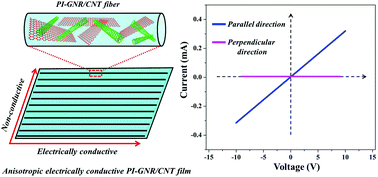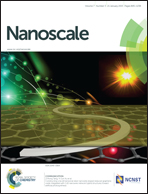Anisotropic conductive films based on highly aligned polyimide fibers containing hybrid materials of graphene nanoribbons and carbon nanotubes†
Abstract
Anisotropic electrically conductive films (PI–GNR/CNT) consisting of highly aligned polyimide (PI) composite fibers with graphene nanoribbon (GNR) and carbon nanotube (CNT) (GNR/CNT) hybrids as nanofillers have been prepared by electrospinning. The GNR/CNT hybrids used here were prepared by one-step partial unzipping of multi-walled CNTs, in which, with the residual CNTs bonded on the randomly arranged GNR sheets, not only the aggregation of GNR sheets was greatly prevented but also an electrically conductive pathway with good conductivity was effectively formed with the CNTs acting as linking bridges between different GNRs. Due to the three-dimensional (3D) conductive network structure of the GNR/CNT hybrid and fine dispersion and alignment inside the PI fibers, as well as the good interfacial interaction between the GNR/CNT hybrid and the PI matrix, PI–GNR/CNT composite films exhibit a unique property of anisotropic electrical conductivity of 8.3 × 10−2 S cm−1 in the parallel direction along the fibers and 7.2 × 10−8 S cm−1 in the perpendicular direction, which may open the way for wide potential applications of anisotropic conductive nanomaterials in practical production and scientific research fields.


 Please wait while we load your content...
Please wait while we load your content...